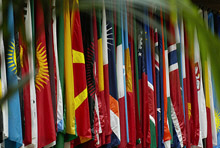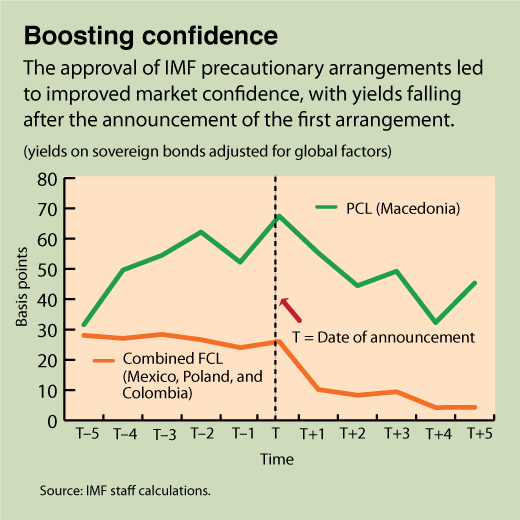
Typical street scene in Santa Ana, El Salvador. (Photo: iStock)
IMF Survey: IMF Revamps Lending Options in Response to Global Crisis
December 7, 2011
- IMF responds to calls for stronger global financial safety net
- Precautionary Credit Line replaced with more flexible instrument to provide liquidity
- New instrument broadens emergency assistance
The IMF has revamped its lending toolkit to bolster its ability to meet the needs of its member countries as global growth continues to weaken in response to the ongoing crisis in the euro area.

In revamp of lending instruments, IMF is upgrading one type of precautionary credit line and broadening reach of its emergency assistance (IMF photo)
IMF LENDING
The reforms, which have been under way for some time, come in response to calls from the Group of Twenty (G-20) industrialized and emerging market economies and the IMF’s broader membership for a stronger global financial safety net to help prevent crises.
The IMF is upgrading one type of precautionary credit line, and broadening the reach of its emergency assistance. The Precautionary and Liquidity Line will enable the IMF to provide upfront liquidity in a broad range of circumstances, including for countries with sound policies that have been affected by economic shocks beyond their control, such as heightened stress in global financial markets.
The Rapid Financing Instrument enhances the IMF’s instruments for emergency assistance, and may be used to support member countries experiencing a range of urgent balance of payments needs, including needs arising from commodity price shocks, natural disasters, post-conflict situations, and other emergencies. The Rapid Financing Instrument will improve the IMF’s ability to provide low-access financial assistance to member countries with urgent financing needs, without the need for a full-fledged program.
“The IMF has been asked to enhance its lending toolkit to help the membership cope with crises. We have acted quickly, and the new tools will enable us to respond more rapidly and effectively for the benefit of the whole membership,” IMF Managing Director Christine Lagarde said.
“The reform enhances the Fund’s ability to provide financing for crisis prevention and resolution. This is another step toward creating an effective global financial safety net to deal with increased global interconnectedness.”
Strengthening the global financial safety net
As part of its broader response to the 2008 global financial crisis, the IMF approved comprehensive reforms to strengthen its capacity to prevent and resolve crises, resulting in the creation of the Flexible Credit Line and the Precautionary Credit Line. To date, three countries—Mexico, Poland, and Colombia—have used the Flexible Credit Line, while Macedonia is the only country to have accessed the Precautionary Credit Line.
As part of the process of preparing the latest lending reforms, the IMF reviewed the role that the Precautionary Credit Line and the Flexible Credit Line played in helping mitigate the effects of the global financial crisis. The review found that both facilities provided valuable insurance during the crisis, and helped boost confidence and moderate balance of payments pressures, not just for the countries that accessed the credit lines, but also for other countries in similar circumstances. The effect can be measured through lower spreads for the four countries that accessed the facilities and lower crisis probabilities for countries in similar circumstances (see chart).

Despite these benefits, demand for the Flexible Credit Line and the Precautionary Credit Line remained limited for a number of reasons. Most countries continue to prefer self-insurance, for instance by building up their foreign reserves, and there are continuing concerns about the stigma of approaching the IMF for financial assistance. Furthermore, the two instruments lacked flexibility in the eyes of some potential users, who also expressed concerns about the perceived subjectivity of the qualification process.
The IMF also conducted a review of its engagement with countries in fragile situations. The review identified that the IMF’s emergency assistance policy is applicable only to a limited set of circumstances and suggested an enhancement of the policy to expand the range of urgent financing needs.
Building on these findings and recent lessons from the global crisis, the IMF decided to replace the Precautionary Credit Line with the more flexible Precautionary and Liquidity Line, and to broaden the reach of its nonconcessional emergency assistance policy by introducing the Rapid Financing Instrument as a replacement for its previous instruments for emergency assistance, known as the Emergency Natural Disaster Assistance and the Emergency Post-Conflict Assistance.
Providing rapid liquidity to good performers and crisis bystanders
The introduction of the Precautionary and Liquidity Line will enable the IMF to provide liquidity in a broader range of circumstances, including as a short-term liquidity window for countries with sound policies affected by exogenous shocks. Such shocks can arise, for instance, as a result of heightened regional or global stress in financial markets.
The Precautionary and Liquidity Line responds to the need to provide adequate liquidity to countries that are threatened by virulent and contagious shocks even though they themselves have sound policies and economic fundamentals―the crisis bystanders. This new credit line builds on the strengths and broadens the scope of the old Precautionary Credit Line.
Among other innovations, the Precautionary and Liquidity Line can be used by countries with an actual financing need at the time of approval of IMF support (the Precautionary Credit Line could only be used by countries with potential financing needs). It also offers the possibility of upfront liquidity to meet immediate short-term financing needs of qualifying countries.
In this way, the Precautionary and Liquidity Line complements the crisis prevention and resolution role of the Flexible Credit Line, which remains in place. As is the case with the Flexible Credit Line, countries qualify for the Precautionary and Liquidity Line through a rigorous qualification process. This is complemented by streamlined conditionality focused on addressing any remaining vulnerabilities.
Arrangements under the Precautionary and Liquidity Line can be approved for a period of six months or 1–2 years, in both cases to address actual or potential financing needs. Six-month arrangements allow upfront access to IMF resources for up to 250 percent of quota.
In exceptional circumstances arising from an exogenous shock, qualifying member countries with larger short-term financing needs could double their access―possibly by means of a single successor short-term arrangement. Six-month arrangements will not be subject to traditional program monitoring involving reviews by the IMF’s staff and Executive Board.
Reaching out to member countries with urgent needs
The new Rapid Financing Instrument will provide rapid emergency assistance to countries facing a full range of urgent financing needs such as those arising from commodity price shocks, natural disasters, and fragile or post-conflict situations. The creation of the Rapid Financing Instrument is part of the IMF’s efforts to enhance the reach and flexibility of its emergency assistance policy, which started with the establishment of the Rapid Credit Facility for low-income countries in July 2009.
The Rapid Financing Instrument is designed for countries whose urgent financing needs could severely disrupt their economies if left unaddressed. It provides for outright access of up to 50 percent of quota annually and 100 percent of quota on a cumulative basis.
Use of the Rapid Financing Instrument is appropriate if the member country’s financing needs are expected to be resolved within one year with no major policy adjustments or if the country is unable to implement a traditional IMF-supported program, due to capacity limitations or because of the urgency of the situation.
The Rapid Financing Instrument does not require traditional IMF conditionality, although countries using the instrument would still need to set out their policy commitments in a letter of intent and be willing to cooperate with the IMF in addressing their difficulties.


